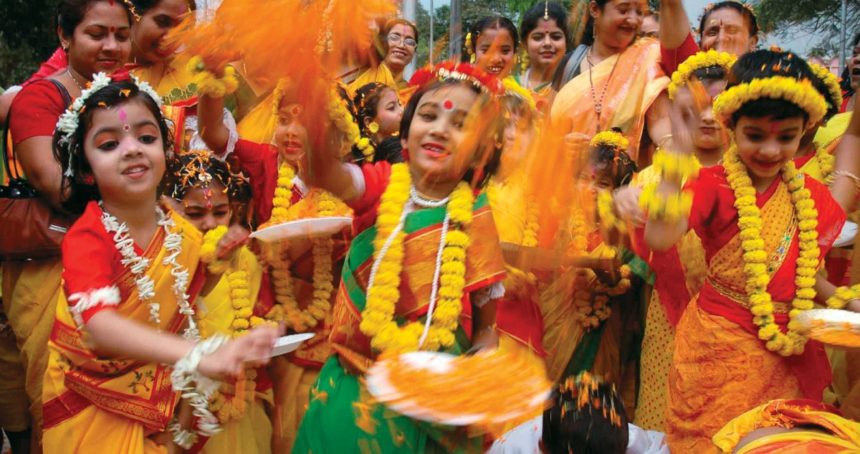Hinduism has always held women in high regard, quite unlike the negative image portrayed by modern society.
Women in Hinduism: Portrayal & Preaching

India as a nation recently celebrated the nine-day festival of Navratri with much fanfare. This celebration was the more vibrant version of the nine-day festival that takes place in the Hindu month of Chaitra (March-April). In both the Navratris, young girls are worshiped as avatars of the goddess and are fed the best possible food and given presents. This is just one of the many festivals where woman are celebrated in Indian culture to commemorate the female divine. The idea of celebrating and respecting women is deeply etched in Hindu society.
During the Diwali festival, two goddesses were worshiped – Ma Saraswati and Ma Mahalaxmi. Both are depicted to be seated along with Ganesh, the remover of obstacles. Ma Saraswati helps her worshipper attain knowledge, while Ma Mahalaxmi blesses her followers with abundance and wealth. A few days after Diwali, Hindus perform Tulsi Vivah, which entails the worshiping of the sacred basil plant. It is only after this puja is performed that it is considered auspicious to conduct marriage ceremonies in the family.
Even during marriage ceremonies, the bride to be is the most important entity in her family. Delving further into how Hinduism wants the daughters to be treated, the concept of Kanyadaan emphasises the stature of women. Kanyadaan is considered to the best ‘daan’ in our culture, that’s why people who don’t have daughters come forward to do ‘kanyadaan’ for other’s daughters. The bride is so sacred that the couples performing the daan touch her feet to receive her blessings.
Apart from that, the festival of Raksha Bandhan (July-August) aims to establish brothers and sisters as complementary, with the sister worshipping her brother and in return, he vows to always respect and protect her. Even Karwa Chauth is a festival that elevates the role of a woman in the marital relationship. But it is considered regressive because the wife has to abstain from food in order to prolong the life of her husband, while he is free to fill his stomach with the choicest delicacies. While this criticism resonates in the context of the current social discourse, in reality, Karwa Chauth is an acknowledgment of how a wife is treated by the husband all through the year, which inspires her to fast for him. A common factor in most Hindu festivals is gifting jewellery and clothes to women. Not just that, there is a concept of ‘stree-dhan’ (the wealth which a woman collects in cash or as jewellery) which is used only in case of emergency. In fact, using this dhan is considered a taboo, and hence families use this dhan in dire needs only.
Such is the importance and reverence of the female divine in the Hindu cosmos that eight Vasus had to take birth on earth as penance to being mute spectators as Shantanu and Ganga kept gazing at each other even as the wind blew away Ganga’s veil. While the Vasus chose to look away from Ganga’s exposed body, they were still punished for their indifference towards the devi and sent to earth as Ganga’s sons. The entire Kaurava clan was wiped out following their egoistic and adharmic actions directed against Draupadi. Ravan and his kingdom suffered dire consequences for forcefully capturing Sita.
The concept of Sati started with a unique story though. Lord Shiva almost destroyed earth when his wife Mata Sati offered herself into the havan flames – after she witnessed Shiva being insulted by her father King Daksh during a yajna. Shiva transformed into his Rudra-roop (the destroyer) only to avenge the death of his wife. He was pacified only when the news of Sati’s reincarnation as Parvati was revealed to him. Isn’t this a story that can inspire men to respect and love their wife, and for women to value their husbands?
Here’s some more information that establishes how Hinduism preaches the idea of respecting women. The Aardhanarishwar avatar consists of vertical body halves of Shiva and Parvati, and it determines man and woman as equals. They are both powerful, and yet they are incomplete without each other and considering one superior over the other is utter folly.
Promoting womanhood as a force to reckon with, Hinduism also portrays women as Chandi – she can nurture, but she can also destroy if need be. The Chandi avatar wears a skeleton garland and her foot is mounted on Shiva, who is respectfully lying on the ground at her feet. There can be no scarier looking avatar of any goddess/god than Chandi, and any sane person can get the idea that one shouldn’t mess with a woman. Hindus also consider cow (a female) sacred and hence, the scriptures talk of nurturing and feeding them. And hence, Hindus feel the need to secure her from the slaughterhouse. But let us not delve deeper into how cows are treated today and the politics on this issues.
In conclusion, there are many stories that have been carefully passed down from generations to generations that talk of respecting women and considering them sacred. That is why we call the most revered entities on this land as Mata – dharti, Ganga and Bharat.

Leave a Reply